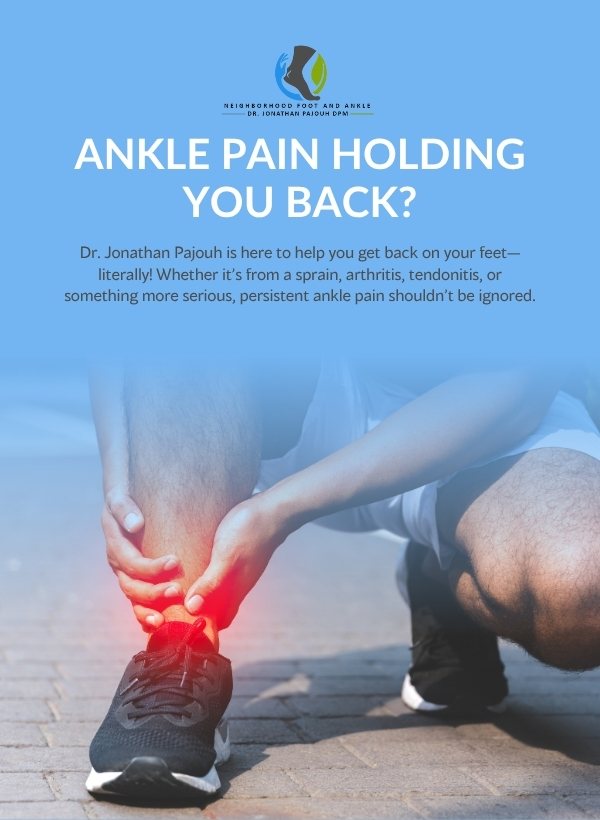
Overcoming Ankle Pain: Your Path to Recovery Starts Here
Did you know that over 25% of adults experience ankle pain at some point in their lives? Whether a minor sprain or chronic issues like arthritis or tendonitis, ankle pain can significantly impact your daily activities. Understanding the causes and effective methods for alleviation can help you regain mobility and quality of life. In this blog, we will explore the various reasons behind ankle pain, effective treatments, and preventive measures you can take to ensure that you stay active and pain-free. Dr. Jonathan Pajouh is here to guide you through this journey to healing. Let’s dive deep into understanding your ankle pain and how to conquer it.
Understanding Ankle Pain: Types and Causes
Ankle pain can manifest in a variety of forms, each associated with different underlying conditions. Understanding the type of pain you experience is essential for navigating the path to recovery. Here are some common types of ankle pain:
1. Acute Ankle Pain: This type often results from injuries, like sprains or fractures. A sudden twist or fall can result in acute pain and swelling.
2. Chronic Ankle Pain: This pain persists over time and may stem from arthritis or tendonitis. Individuals with chronic pain often have a continuous dull ache.
3. Referred Pain: Sometimes, pain in the ankle may be felt due to issues in the foot or knee. Conditions like shin splints or plantar fasciitis can cause referred pain, complicating diagnosis.
Key Causes of Ankle Pain
Understanding what is causing your ankle pain is the first step in treatment. Here are some typical causes:
- Injuries: Sprains and fractures are among the most common causes of ankle pain. A sprain occurs when the ligaments that support the ankle stretch or tear.
- Arthritis: Osteoarthritis is the wear-and-tear type, while rheumatoid arthritis is an autoimmune condition that can affect the ankle joint as well.
- Tendonitis: Inflammation of the tendons in the ankle can lead to significant discomfort, particularly among athletes or individuals involved in high-impact activities.
- Nerve Issues: Conditions affecting the nerves, like diabetic neuropathy, can result in pain or discomfort in the ankles.
- Poor Footwear: Wearing poorly designed shoes can cause additional stress on the ankles, leading to pain.
Diagnosis of Ankle Pain
If you’re experiencing persistent ankle pain, it is vital to consult a healthcare professional for proper diagnosis. Diagnostic processes may include:
- Physical Examination: The doctor will examine your ankle, checking for tenderness, swelling, and range of motion.
- Imaging Tests: X-rays can rule out fractures, while MRIs can provide detailed images of soft tissues including ligaments, tendons, and cartilage.
- Blood Tests: In cases where arthritis or infections are suspected, blood tests may help in diagnosing the underlying cause.
Treatment Options for Ankle Pain
Once a diagnosis has been established, various treatment options can provide relief from ankle pain. Here are some methods commonly employed:
- Rest and Ice: Initially treating injuries with rest and applying ice can help reduce swelling.
- Physical Therapy: Engaging in targeted physical therapy sessions can help strengthen the ankle and improve flexibility.
- Medication: Over-the-counter pain relievers help manage swelling and discomfort. In some cases, corticosteroid injections may be recommended for severe inflammation.
- Surgery: In situations where conservative treatments fail, surgical intervention may be necessary, especially for persistent conditions such as severe arthritis or tendon tears.
- Orthotics: Special shoes or inserts can help relieve pressure on the ankle and redistribute weight.
Preventing Ankle Pain
In addition to treatment, taking preventive measures can significantly reduce the likelihood of ankle pain in the future. Here are some steps you can take:
- Warm-Up and Stretch: Before any physical activity, ensure a proper warm-up routine followed by stretching exercises targeting the lower legs.
- Choose Appropriate Footwear: Proper shoes that provide adequate support and cushioning are crucial for preventing injuries.
- Gradual Increase in Activity: If you are starting a new exercise or sport, increase your activity level gradually to avoid overloading your ankles.
- Strength Training: Engaging in exercises that strengthen the muscles around the ankle can help support the joint and prevent injuries.
- Stay Educated: Understanding your body's limits and knowing when to seek medical advice is essential for long-term health.
When To Seek Professional Help
If your ankle pain is severe, persistent, or is accompanied by other symptoms like swelling, bruising, or instability, seeking professional care is imperative. Dr. Jonathan Pajouh will work with you to create a tailored plan that addresses your specific needs and helps you return to an active lifestyle.
Recovery and Lifestyle Adjustments
Once you’ve begun treatment, making lifestyle adjustments can significantly aid recovery. Here are some tips:
- Stay Hydrated: Proper hydration is crucial for muscle recovery and overall joint health.
- Maintain a Healthy Weight: Reducing strain on your ankles by managing your weight can be highly beneficial.
- Cross-Training: Participate in a variety of exercises to strengthen different muscle groups without overworking your ankles.
- Listen to Your Body: If you experience pain during specific activities, modify your approach or seek guidance from a professional.
The Importance of Continuous Care
Even when feeling better, it’s vital to monitor your ankles. Consider regular check-ups to stay on top of any developing issues and to adjust your preventive routines accordingly.
So, What Changes Can You Make at Home?
By implementing preventive strategies and seeking guidance, you can effectively manage and overcome ankle pain. Whether through exercises, proper footwear, or lifestyle changes, taking proactive steps can keep you on your feet. Don’t let pain hold you back—embrace the freedom of mobility!
Schedule Your Appointment
For personalized support or to seek professional care, schedule an appointment with Dr. Jonathan Pajouh.
Contact Us – Reconstructive Podiatric Foot & Ankle Surgeon, Dallas TX
